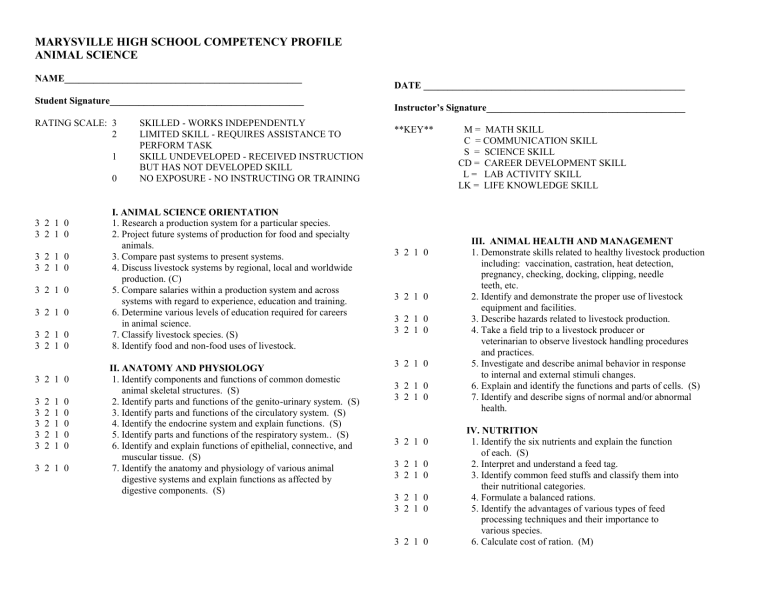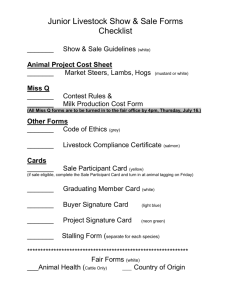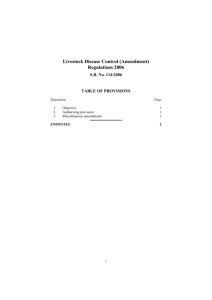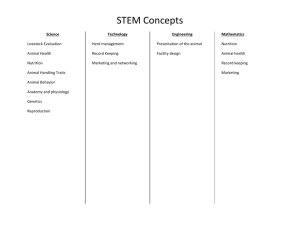marysville high school competency profile

MARYSVILLE HIGH SCHOOL COMPETENCY PROFILE
ANIMAL SCIENCE
NAME_________________________________________________
Student Signature________________________________________
RATING SCALE: 3
2
SKILLED - WORKS INDEPENDENTLY
LIMITED SKILL - REQUIRES ASSISTANCE TO
1
0
PERFORM TASK
SKILL UNDEVELOPED - RECEIVED INSTRUCTION
BUT HAS NOT DEVELOPED SKILL
NO EXPOSURE - NO INSTRUCTING OR TRAINING
3 2 1 0
3 2 1 0
3 2 1 0
3 2 1 0
I. ANIMAL SCIENCE ORIENTATION
1. Research a production system for a particular species.
2. Project future systems of production for food and specialty
animals.
3. Compare past systems to present systems.
4. Discuss livestock systems by regional, local and worldwide
3 2 1 0
3 2 1 0
3 2 1 0
3 2 1 0
3 2 1 0
3 2 1 0
3 2 1 0
3 2 1 0
3 2 1 0
3 2 1 0
production. (C)
5. Compare salaries within a production system and across
systems with regard to experience, education and training.
6. Determine various levels of education required for careers
in animal science.
7. Classify livestock species. (S)
8. Identify food and non-food uses of livestock.
II. ANATOMY AND PHYSIOLOGY
1. Identify components and functions of common domestic
animal skeletal structures. (S)
2. Identify parts and functions of the genito-urinary system. (S)
3. Identify parts and functions of the circulatory system. (S)
4. Identify the endocrine system and explain functions. (S)
5. Identify parts and functions of the respiratory system.. (S)
6. Identify and explain functions of epithelial, connective, and
3 2 1 0
muscular tissue. (S)
7. Identify the anatomy and physiology of various animal
digestive systems and explain functions as affected by
digestive components. (S)
3 2 1 0
3 2 1 0
3 2 1 0
3 2 1 0
3 2 1 0
3 2 1 0
3 2 1 0
3 2 1 0
3 2 1 0
3 2 1 0
3 2 1 0
3 2 1 0
3 2 1 0
DATE ______________________________________________________
Instructor’s Signature_________________________________________
**KEY** M = MATH SKILL
C = COMMUNICATION SKILL
S = SCIENCE SKILL
CD = CAREER DEVELOPMENT SKILL
L = LAB ACTIVITY SKILL
LK = LIFE KNOWLEDGE SKILL
III. ANIMAL HEALTH AND MANAGEMENT
1. Demonstrate skills related to healthy livestock production
including: vaccination, castration, heat detection,
pregnancy, checking, docking, clipping, needle
teeth, etc.
2. Identify and demonstrate the proper use of livestock
equipment and facilities.
3. Describe hazards related to livestock production.
4. Take a field trip to a livestock producer or
veterinarian to observe livestock handling procedures
and practices.
5. Investigate and describe animal behavior in response
to internal and external stimuli changes.
6. Explain and identify the functions and parts of cells. (S)
7. Identify and describe signs of normal and/or abnormal
health.
IV. NUTRITION
1. Identify the six nutrients and explain the function
of each. (S)
2. Interpret and understand a feed tag.
3. Identify common feed stuffs and classify them into
their nutritional categories.
4. Formulate a balanced rations.
5. Identify the advantages of various types of feed
processing techniques and their importance to
various species.
6. Calculate cost of ration. (M)
3 2 1 0
3 2 1 0
3 2 1 0
3 2 1 0
3 2 1 0
3 2 1 0
3 2 1 0
3 2 1 0
3 2 1 0
3 2 1 0
3 2 1 0
3 2 1 0
3 2 1 0
3 2 1 0
3 2 1 0
3 2 1 0 7. Describe the nutritional impact of range and pasture
management practices.
V. GENETICS
3 2 1 0 1. Explain how genetics relates to improvement in
3 2 1 0
3 2 1 0
3 2 1 0
3 2 1 0
3 2 1 0
efficient livestock production. (S)
2. Investigate and describe how DNA carries the genetic code. (S)
3. Describe how genes and chromosomes affect the genotype and
phenotype of animals. (S)
4. Understand and explain mutations. (S)
5. Define heritability and discuss how genetics and environment
influence the phenotype of animals. (S)
6. Interpret performance data.
VI. MARKETING
1. List and differentiate between methods of marketing
(auction alternatives, direct sale, terminal).
2. Identify marketing techniques and demonstrate proper
calculation of marketing problems, such as futures, hedging,
options, contract sale.
3. List price factors affecting quality and yield grade.
4. Describe economic value of livestock to USA and Kansas.
VII. CURRENT ANIMAL AG ISSUES
1. Identify and discuss the major issues impacting the
livestock industry.
2. Discuss different livestock production systems and
their effect on the community and environment.
3. Select, research and debate an animal issue, i.e. cloning,
waste management, animal rights, organic farming,
global warming. (C)
VIII. REPRODUCTION
1. Describe management care to maximize reproductive
efficiencies.
2. Define terminology required to study and apply
reproductive management.
3. Identify reproductive maturity states of animals.
4. Identify gestation period length in animals.
5. Discuss the states of embryo and fetal development.
IX. ANIMAL PRODUCTS
1. Outline humane slaughtering and processing procedures.
2. Explain safe handling of meat, poultry and dairy products.
3. Differentiate between various U.S.D.A. grades for various
animal related products.
3 2 1 0
3 2 1 0
3 2 1 0
3 2 1 0
3 2 1 0
3 2 1 0
3 2 1 0
3 2 1 0
3 2 1 0
3 2 1 0
3 2 1 0
3 2 1 0
3 2 1 0
3 2 1 0
3 2 1 0
3 2 1 0
3 2 1 0
4. Identify livestock inspection procedures.
5. Identify wholesale and retail cuts of meat and
poultry.
X. FISH AND WILDLIFE
1. Understand the relationship between ecology
and agriculture.
2. Identify and manage wildlife resources.
3. Explain problems related to endangered species.
4. Identify methods of aquaculture management
and production.
XI. CAREER DEVELOPMENT SKILLS (CD, LK)
1. Compile a list of animal science career areas.
2. Discuss salary, job opportunities, and educational
training required for specific careers.
3. Compose a letter of application and personal
resume for a selected animal science career. (C)
4. Participate in mock interviews.
XII. SAE (CD, LK)
1 Complete livestock production records.
2. Track feed records for a one year period.
3. Plan a cash flow for a given production operation.
4. Record birthing records for a production operation.
XIII. FFA (CD, LK)
1. Prepare for and compete in an animal related CDE.
2. Participate in local FFA activities.
3. Present a 6 to 8 minute presentation.






